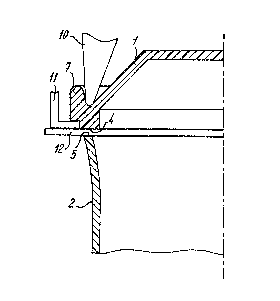Une partie des informations de ce site Web a été fournie par des sources externes. Le gouvernement du Canada n'assume aucune responsabilité concernant la précision, l'actualité ou la fiabilité des informations fournies par les sources externes. Les utilisateurs qui désirent employer cette information devraient consulter directement la source des informations. Le contenu fourni par les sources externes n'est pas assujetti aux exigences sur les langues officielles, la protection des renseignements personnels et l'accessibilité.
L'apparition de différences dans le texte et l'image des Revendications et de l'Abrégé dépend du moment auquel le document est publié. Les textes des Revendications et de l'Abrégé sont affichés :
| (12) Brevet: | (11) CA 1264216 |
|---|---|
| (21) Numéro de la demande: | 1264216 |
| (54) Titre français: | METHODE ET DISPOSITIF DE RACCORDEMENT PAR SOUDAGE ABOUTE A L'OUTIL CHAUFFE, DU CORPS EXTRUDE D'UN CONTENANT ET DE SON COUVERCLE |
| (54) Titre anglais: | PROCESS AND DEVICE FOR CONNECTING TOGETHER BY HEATED- TOOL BUTT-WELDING A VESSEL BODY OBTAINED BY EXTRUSION AND A VESSEL LID |
| Statut: | Périmé et au-delà du délai pour l’annulation |
| (51) Classification internationale des brevets (CIB): |
|
|---|---|
| (72) Inventeurs : |
|
| (73) Titulaires : |
|
| (71) Demandeurs : |
|
| (74) Agent: | GOWLING WLG (CANADA) LLP |
| (74) Co-agent: | |
| (45) Délivré: | 1990-01-09 |
| (22) Date de dépôt: | 1986-07-16 |
| Licence disponible: | S.O. |
| Cédé au domaine public: | S.O. |
| (25) Langue des documents déposés: | Anglais |
| Traité de coopération en matière de brevets (PCT): | Non |
|---|
| (30) Données de priorité de la demande: | S.O. |
|---|
ABSTRACT
Process and device for connecting together an extruded plastic
cylindrical vessel body (2) with a plastic lid (1) by means of butt-
welding of edges (4.5) heated with a heated plate (12) the said lid
being deformed elastically to a larger diameter prior to butt-welding,
the device for expanding the lid (1) having a conical expansion element
(9), a supporting ring (10) and locking elements (11) holding the
expanded lid at a diameter corresponding to the edge diameter of the
body (2).
Note : Les revendications sont présentées dans la langue officielle dans laquelle elles ont été soumises.
Note : Les descriptions sont présentées dans la langue officielle dans laquelle elles ont été soumises.

2024-08-01 : Dans le cadre de la transition vers les Brevets de nouvelle génération (BNG), la base de données sur les brevets canadiens (BDBC) contient désormais un Historique d'événement plus détaillé, qui reproduit le Journal des événements de notre nouvelle solution interne.
Veuillez noter que les événements débutant par « Inactive : » se réfèrent à des événements qui ne sont plus utilisés dans notre nouvelle solution interne.
Pour une meilleure compréhension de l'état de la demande ou brevet qui figure sur cette page, la rubrique Mise en garde , et les descriptions de Brevet , Historique d'événement , Taxes périodiques et Historique des paiements devraient être consultées.
| Description | Date |
|---|---|
| Le délai pour l'annulation est expiré | 2003-01-09 |
| Lettre envoyée | 2002-01-09 |
| Inactive : Grandeur de l'entité changée | 2000-01-07 |
| Lettre envoyée | 1999-08-12 |
| Lettre envoyée | 1999-08-12 |
| Inactive : Transferts multiples | 1999-05-10 |
| Accordé par délivrance | 1990-01-09 |
Il n'y a pas d'historique d'abandonnement
| Type de taxes | Anniversaire | Échéance | Date payée |
|---|---|---|---|
| Annulation de la péremption réputée | 1999-01-11 | 1998-01-05 | |
| TM (catégorie 1, 8e anniv.) - petite | 1998-01-20 | 1998-01-05 | |
| TM (catégorie 1, 9e anniv.) - petite | 1999-01-11 | 1998-12-15 | |
| Annulation de la péremption réputée | 1999-01-11 | 1998-12-15 | |
| Enregistrement d'un document | 1999-05-10 | ||
| TM (catégorie 1, 10e anniv.) - générale | 2000-01-10 | 1999-12-16 | |
| TM (catégorie 1, 11e anniv.) - générale | 2001-01-09 | 2001-01-09 |
Les titulaires actuels et antérieures au dossier sont affichés en ordre alphabétique.
| Titulaires actuels au dossier |
|---|
| KONINKLIJKE EMBALLAGE INDUSTRIE VAN LEER N.V. |
| Titulaires antérieures au dossier |
|---|
| BERNARD JOHAN DE LOOS |
| EDWARD JAMES FARRINGTON |
| GERRIT JAN VAN KEIMPEMA |